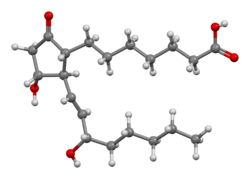Chemistry:Prostaglandin E1
 | |
 | |
| Clinical data | |
|---|---|
| Trade names | Caverject, Muse, others |
| AHFS/Drugs.com | Monograph |
| MedlinePlus | a695022 |
| License data |
|
| Pregnancy category |
|
| Routes of administration | IV |
| ATC code | |
| Legal status | |
| Legal status | |
| Identifiers | |
| |
| CAS Number | |
| PubChem CID | |
| IUPHAR/BPS | |
| DrugBank | |
| ChemSpider | |
| UNII | |
| KEGG | |
| ChEBI | |
| ChEMBL | |
| Chemical and physical data | |
| Formula | C20H34O5 |
| Molar mass | 354.487 g·mol−1 |
| 3D model (JSmol) | |
| |
| |
| | |
Prostaglandin E1 (PGE1) is a naturally occurring prostaglandin and is also used as a medication (alprostadil).[1]
In infants with congenital heart defects, it is delivered by slow injection into a vein to open the ductus arteriosus until surgery can be carried out.[2] By injection into the penis or placement in the urethra, it is used to treat erectile dysfunction.[3]
Common side effects when given to babies include decreased breathing, fever, and low blood pressure.[1] When injected into the penis for erectile dysfunction; side effects may include penile pain, bleeding at the site of injection, and prolonged erection (priapism).[1] Prostaglandin E1 is in the vasodilator family of medications.[1] It works by opening blood vessels and relaxing smooth muscle.[1]
Prostaglandin E1 was isolated in 1957 and approved for medical use in the United States in 1981.[1][4] It is on the World Health Organization's List of Essential Medicines.[5]
Biosynthesis
Prostaglandin E1 is biosynthesized on an as-needed basis from dihomo-γ-linolenic acid (an omega-6 fatty acid) in healthy humans without coronary artery disease[6] and/or a genetic disorder.
Medical uses
Patent ductus arteriosus
Alprostadil is also used in maintaining a patent ductus arteriosus in newborns, primarily for an infant with ductal-dependent congenital heart disease, including cyanotic lesions and acyanotic lesions.
Sexual dysfunction
Alprostadil is sold in the United States as urethral suppositories and in injectable form. The suppositories are sold under the brand name Muse.[7] The injectable forms are Edex[8] and Caverject.[9] Muse delivers alprostadil as a penile suppository, inserted into the urethra, at least ten minutes before the erection is needed. Caverject and Edex are similarly fast-acting, but instead are injected by the syringe directly into the corpus cavernosum of the penis.
Alprostadil is also available as a generic. It must be mixed by a compounding pharmacy. The different formulations, including Bimix and Trimix, may include papaverine and/or phentolamine. A typical mix might be 30 mg of papaverine, 2 mg of phentolamine, and 20 μg alprostadil.
This section contains content that is written like an advertisement. (May 2021) (Learn how and when to remove this template message) |
The compound has been made into an applicable topical cream form known as Vitaros.[10] Made by Takeda UK Ltd., it contains either 200 or 300 μg of alprostadil in 100 mg of cream. The tip of the device is placed in the urethral meatus, and the cream is delivered into the urethra. Clinical trials for the treatment showed positive results in around 3,000 men that it was tested on; it is said to be usable by men with diabetes or heart problems and those who have undergone a prostatectomy.[11] It has no known interactions with food, alcohol or other medications.
Critical limb ischemia
Prostanoids, including alprostadil, do not reduce the risk of limb amputation but may offer a slight improvement in rest-pain and leg ulcer healing in persons with critical limb ischemia.[12]
Contrast-induced nephropathy
Preventative administration of alprostadil may reduce the risk of kidney injury (specifically contrast-induced nephropathy) in persons having cardiac angiography or percutaneous coronary intervention.[13][14]
Adverse effects
- Accidental injury (Muse only)
- Apnea
- Bleeding:
- Cerebral
- Urethral
- Bradycardia
- Cardiac arrest
- Congestive heart failure
- Cortical proliferation of long bones
- Diarrhea
- Disseminated intravascular coagulation
- Edema
- Fever
- Flushing
- Hyperemia
- Hypotension
- Injection-site haematoma
- Injection-site ecchymosis (Caverject only)
- Pain:
- Back
- Pelvic
- Penile
- Testicular (Muse only)
- Urethral
- Prolonged erection
- Penile fibrosis
- Second-degree heart block
- Seizures
- Sepsis
- Shock
- Spasm of right ventricle infundibulum
- Supraventricular tachycardia
- Tachycardia
- Ventricular fibrillation
- Urethral burning
- Uterine rupture
Other versions
Misoprostol is another synthetic prostaglandin E1 analog used to prevent gastric ulcers when taken on a continuous basis,[15] to treat missed miscarriage,[16] to induce labor,[17] and to induce abortion.[18]
References
- ↑ 1.0 1.1 1.2 1.3 1.4 1.5 "Alprostadil". The American Society of Health-System Pharmacists. https://www.drugs.com/monograph/alprostadil.html.
- ↑ Northern Neonatal Network (208) (in en). Neonatal Formulary: Drug Use in Pregnancy and the First Year of Life (5 ed.). John Wiley & Sons. p. 2010. ISBN 9780470750353. https://books.google.com/books?id=aumIBqHmChwC&pg=PA210.
- ↑ British National Formulary (BNF) (69th ed.). British Medical Association. 2015. p. 569. ISBN 9780857111562.
- ↑ (in en) Drug Discovery: A History. John Wiley & Sons. 2005. p. 185. ISBN 9780470015520. https://books.google.com/books?id=jglFsz5EJR8C&pg=PA185.
- ↑ World Health Organization model list of essential medicines: 21st list 2019. Geneva: World Health Organization. 2019. WHO/MVP/EMP/IAU/2019.06. License: CC BY-NC-SA 3.0 IGO.
- ↑ Meller SM, Stilp E, Walker CN, Mena-Hurtado C (2013). "The link between vasculogenic erectile dysfunction, coronary artery disease, and peripheral artery disease: role of metabolic factors and endovascular therapy.". J Invasive Cardiol 25 (6): 313–9. PMID 23735361. https://www.ncbi.nlm.nih.gov/entrez/eutils/elink.fcgi?dbfrom=pubmed&tool=sumsearch.org/cite&retmode=ref&cmd=prlinks&id=23735361.
- ↑ "Muse Suppository - Facts and Comparisons". Drugs.com. https://www.drugs.com/cdi/muse-suppository.html.
- ↑ "Edex - Facts and Comparisons". Drugs.com. https://www.drugs.com/cdi/edex.html.
- ↑ "Caverject - Facts and Comparisons". Drugs.com. https://www.drugs.com/cdi/caverject.html.
- ↑ "Vitaros 3 mg/g cream - Summary of Product Characteristics". Medicines.org.uk. https://www.medicines.org.uk/emc/medicine/28866.
- ↑ "Vitaros- New Erectile Dysfunction Topical Treatment". Meds4All.co.uk. http://www.meds4all.co.uk/blog/Sexual%20Health/vitaros-erectile-dysfunction.html.
- ↑ "Prostanoids for critical limb ischaemia". The Cochrane Database of Systematic Reviews 1 (1): CD006544. January 2018. doi:10.1002/14651858.CD006544.pub3. PMID 29318581.
- ↑ "The effect of alprostadil on preventing contrast-induced nephropathy for percutaneous coronary intervention in diabetic patients: A systematic review and meta-analysis". Medicine 95 (46): e5306. November 2016. doi:10.1097/MD.0000000000005306. PMID 27861357.
- ↑ "Effect of Alprostadil on the Prevention of Contrast-Induced Nephropathy: A Meta-Analysis of 36 Randomized Controlled Trials". Angiology 70 (7): 594–612. August 2019. doi:10.1177/0003319719825597. PMID 30669852.
- ↑ "Misoprostol for the treatment of peptic ulcer and antiinflammatory-drug-induced gastroduodenal ulceration". The New England Journal of Medicine 327 (22): 1575–1580. November 1992. doi:10.1056/NEJM199211263272207. PMID 1435885.
- ↑ "Misoprostol for medical treatment of missed abortion: a systematic review and network meta-analysis". Scientific Reports 7 (1): 1664. May 2017. doi:10.1038/s41598-017-01892-0. PMID 28490770. Bibcode: 2017NatSR...7.1664W.
- ↑ Misoprostol for Cervical Ripening and Induction of Labour: A Review of Clinical Effectiveness, Cost-Effectiveness and Guidelines. CADTH Rapid Response Reports. Ottawa (ON): Canadian Agency for Drugs and Technologies in Health. 2018. http://www.ncbi.nlm.nih.gov/books/NBK538944/.
- ↑ "Medical abortion" (in en). Mayo Clinic. https://www.mayoclinic.org/tests-procedures/medical-abortion/about/pac-20394687.
External links
- "Alprostadil". Drug Information Portal. U.S. National Library of Medicine. https://druginfo.nlm.nih.gov/drugportal/name/alprostadil.
 |

